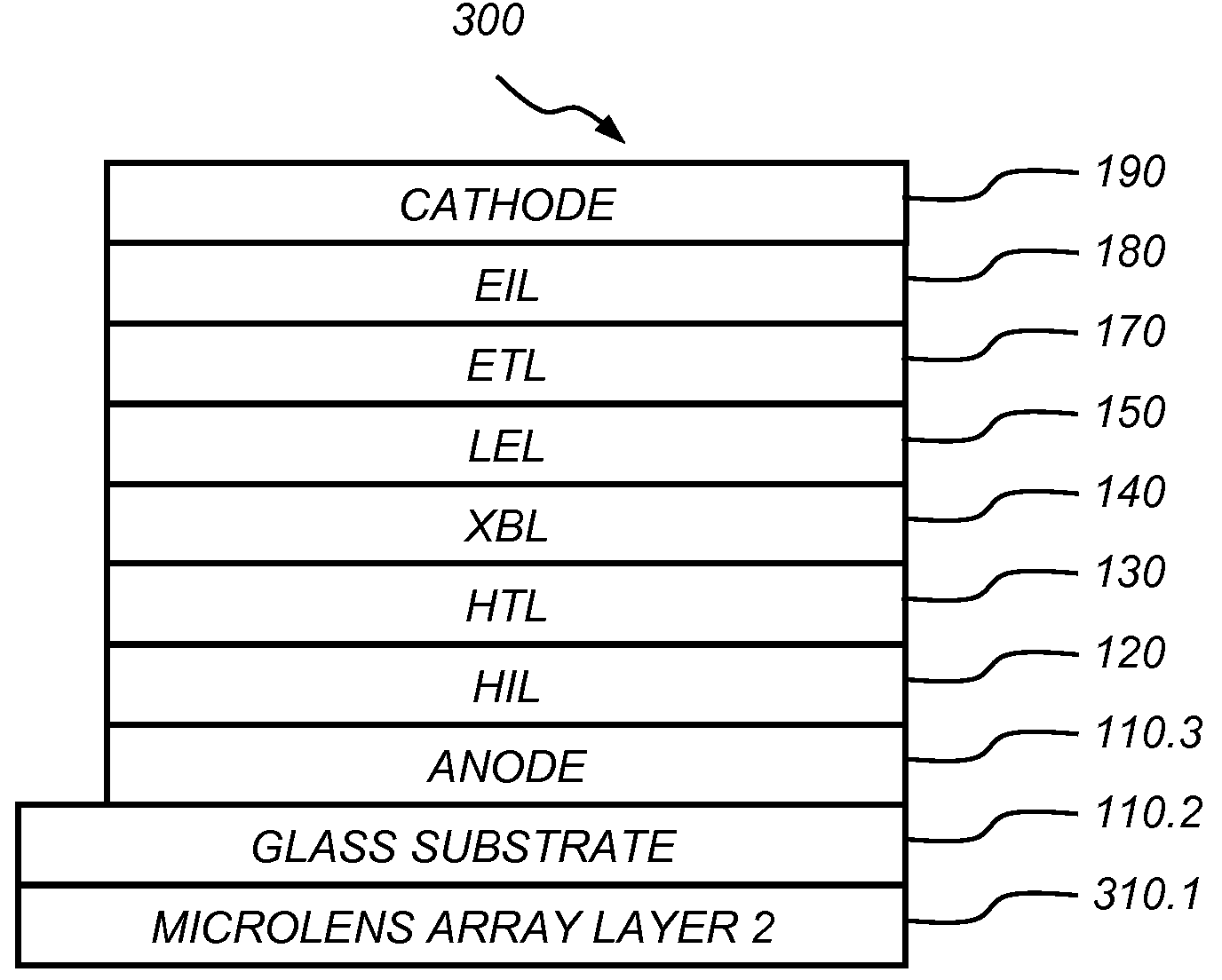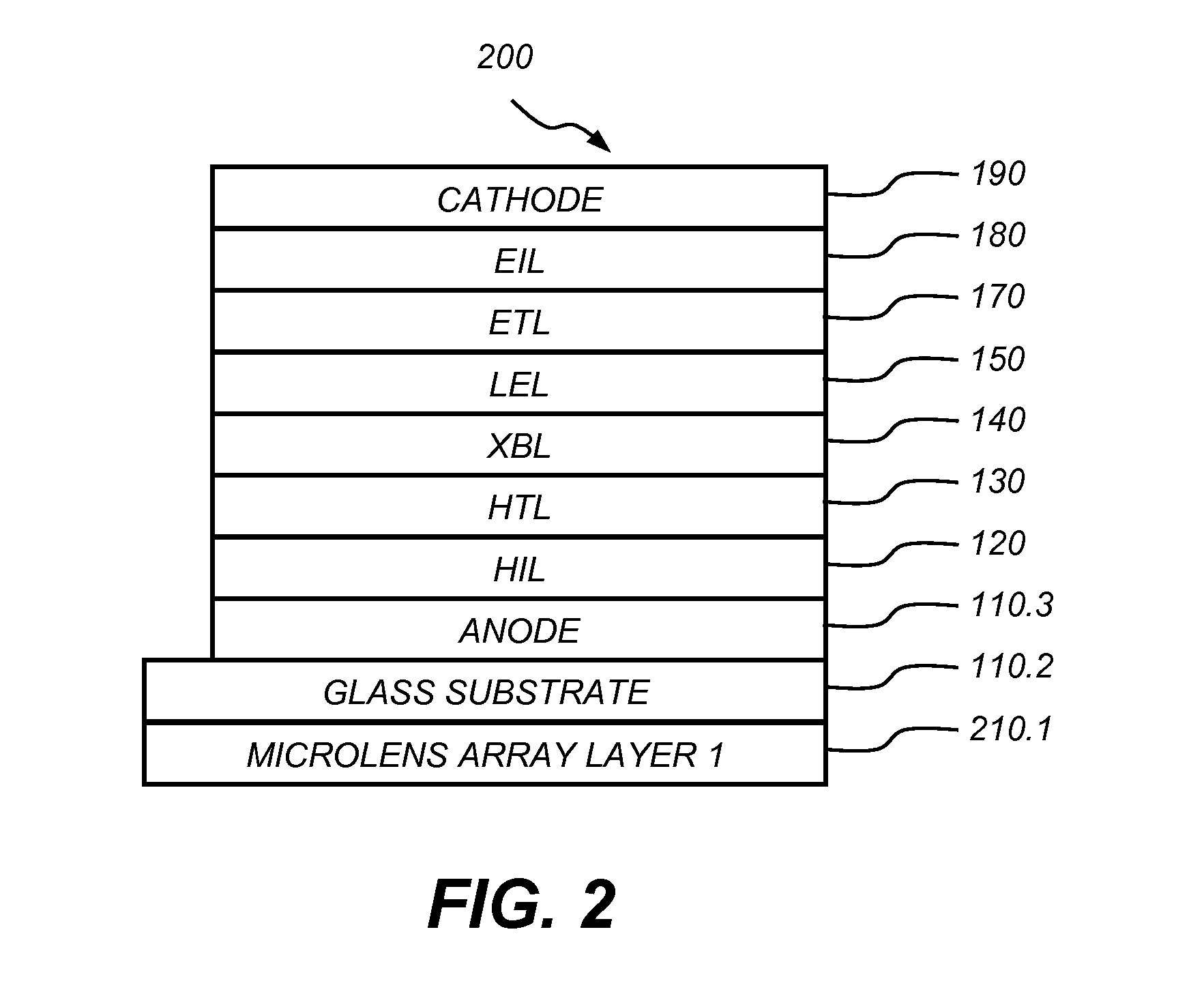Light emitting device with microlens array
a light emitting device and microlens technology, which is applied in the direction of instruments, discharge tubes, luminescnet screens, etc., can solve the problems of limiting the efficiency of oled devices, ineffective capture of most of inability to extract the photons generated by the recombination process, so as to minimize undesirable diffractive effects, enhance the properties of the devices, and improve the diffusion of ambient light
- Summary
- Abstract
- Description
- Claims
- Application Information
AI Technical Summary
Benefits of technology
Problems solved by technology
Method used
Image
Examples
example 1
Microlens Array
[0057]This example illustrates a method of preparation of a microlens array employed in accordance with an embodiment of the invention.
[0058]A solution containing 20 wt % of a copolymer of bisphenol A polycarbonate (BPAC) and polydimethylsiloxane (PDMS) (49.5 mol % bisphenol A, 50 mol % polycarbonate and 1 mol % PDMS; average molecular weight of 92,000 and 31 repeat units of dimethylsiloxane in each PDMS block) and 0.1% FC431 fluorocarbon surfactant (based on the weight of polymer) in methylene chloride was applied on the vinylidene chloride subbed surface of a sheet of polyethyleneterephthalate (PET) at a wet thickness of 0.25 mm. The wet coating was then immediately inserted into a closed chamber where the temperature and humidity were controlled at 22 C and 65% RH and kept there for 5 minutes. After evaporation of the organic solvent, the sheet was kept in the chamber for an additional 5 minutes and the chamber was purged with nitrogen gas to remove residual water....
example 2
Microlens Array
[0061]This example illustrates preparation of a microlens array employed in a comparative example.
[0062]A solution containing 23.8 wt % polycarbonate (Bayer DPI 1265) and 0.1% FC431 fluorocarbon surfactant (based on the weight of polycarbonate) in dichloromethane was applied on the surface of a sheet of polyethyleneterephthalate (PET) at a coverage of 452 cm3 / m2. The wet coating was then immediately inserted into a closed chamber where the temperature and humidity were controlled at 22 C and 85% RH and kept there for 5 minutes. After evaporation of the organic solvent, the sheet was kept in the chamber for an additional 5 minutes and the chamber was purged with nitrogen gas to remove residual water. The resulting dried polymer film was then peeled off the PET substrate. The film was structured with closely packed hemispherical cavities. Sylgard 184 silicone elastomer base (from Dow Coming Corporation) was combined with Sylgard curing agent (also from Dow Coming) in a ...
example 3
Comparative Device
[0063]The preparation of a conventional OLED (Device 1) is as follows: A 1.1 mm thick glass substrate (refractive index 1.52) coated with a transparent indium-tin-oxide (ITO) conductive layer was cleaned and dried using a commercial glass scrubber tool. The thickness of ITO is about 100 nm and the sheet resistance of the ITO is about 30 Ω / square. The ITO surface was subsequently treated with oxidative plasma to condition the surface as an anode. A layer of CFx, 1 nm thick, was deposited on the clean ITO surface as the anode buffer layer by decomposing CHF3 gas in an RF plasma treatment chamber. The substrate was then transferred into a vacuum deposition chamber for deposition of all other layers on top of the substrate. The following layers were deposited in the following sequence by evaporation from a heated boat under a vacuum of approximately 10−6 Torr:
[0064]a) a hole-injecting layer (HIL), 10 nm thick, including hexaazatriphenylene hexacarbonitrile (HAT—CN);
[00...
PUM
| Property | Measurement | Unit |
|---|---|---|
| diameter | aaaaa | aaaaa |
| refractive index | aaaaa | aaaaa |
| mean cavity diameter | aaaaa | aaaaa |
Abstract
Description
Claims
Application Information
 Login to View More
Login to View More - R&D
- Intellectual Property
- Life Sciences
- Materials
- Tech Scout
- Unparalleled Data Quality
- Higher Quality Content
- 60% Fewer Hallucinations
Browse by: Latest US Patents, China's latest patents, Technical Efficacy Thesaurus, Application Domain, Technology Topic, Popular Technical Reports.
© 2025 PatSnap. All rights reserved.Legal|Privacy policy|Modern Slavery Act Transparency Statement|Sitemap|About US| Contact US: help@patsnap.com



